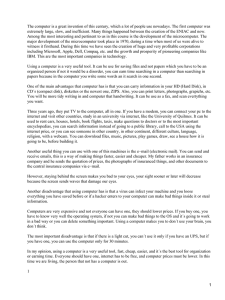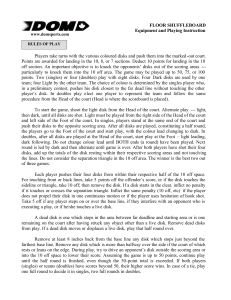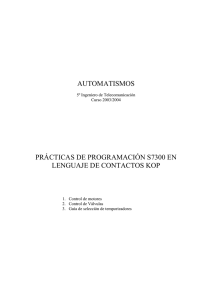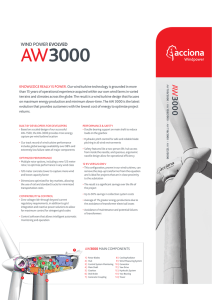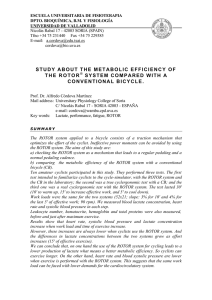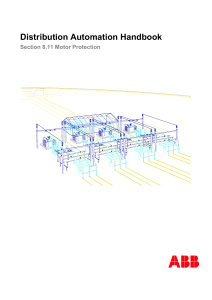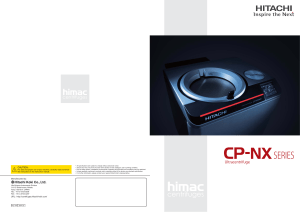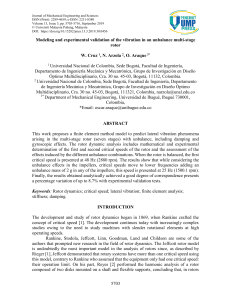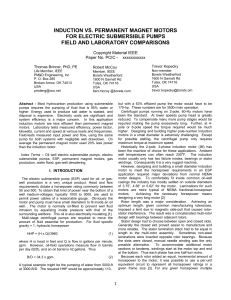Disk-shaped superconductor rotor for an axial flux induction motor
Anuncio
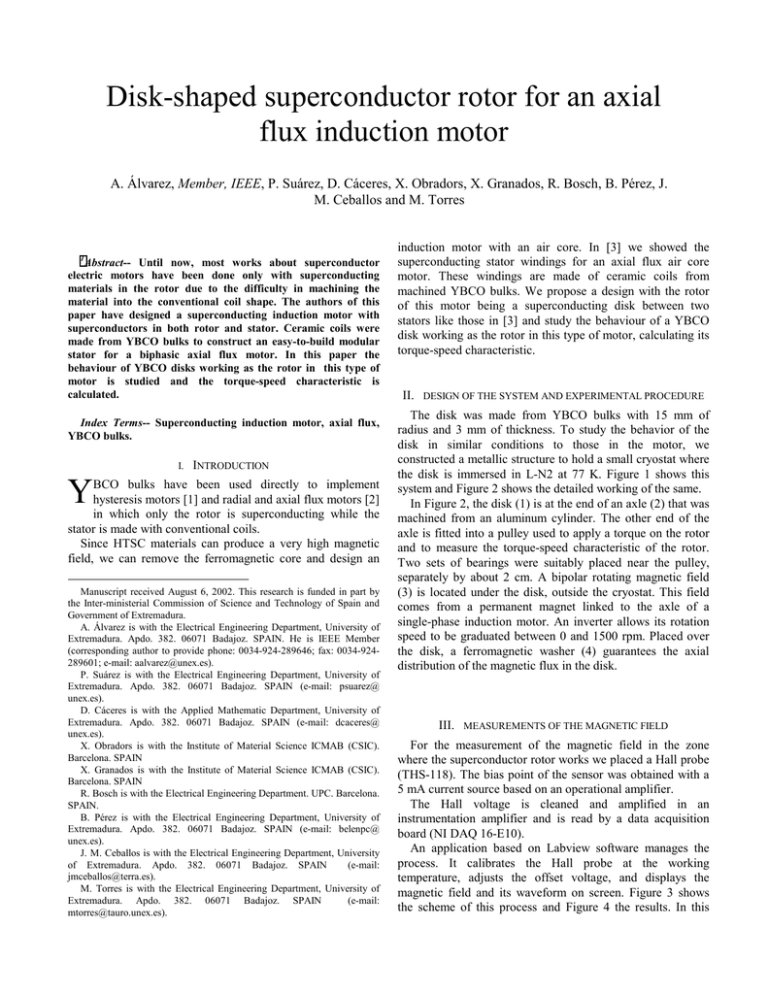
Disk-shaped superconductor rotor for an axial flux induction motor A. Álvarez, Member, IEEE, P. Suárez, D. Cáceres, X. Obradors, X. Granados, R. Bosch, B. Pérez, J. M. Ceballos and M. Torres 1 Abstract-- Until now, most works about superconductor electric motors have been done only with superconducting materials in the rotor due to the difficulty in machining the material into the conventional coil shape. The authors of this paper have designed a superconducting induction motor with superconductors in both rotor and stator. Ceramic coils were made from YBCO bulks to construct an easy-to-build modular stator for a biphasic axial flux motor. In this paper the behaviour of YBCO disks working as the rotor in this type of motor is studied and the torque-speed characteristic is calculated. Index Terms-- Superconducting induction motor, axial flux, YBCO bulks. I. INTRODUCTION Y BCO bulks have been used directly to implement hysteresis motors [1] and radial and axial flux motors [2] in which only the rotor is superconducting while the stator is made with conventional coils. Since HTSC materials can produce a very high magnetic field, we can remove the ferromagnetic core and design an Manuscript received August 6, 2002. This research is funded in part by the Inter-ministerial Commission of Science and Technology of Spain and Government of Extremadura. A. Álvarez is with the Electrical Engineering Department, University of Extremadura. Apdo. 382. 06071 Badajoz. SPAIN. He is IEEE Member (corresponding author to provide phone: 0034-924-289646; fax: 0034-924289601; e-mail: [email protected]). P. Suárez is with the Electrical Engineering Department, University of Extremadura. Apdo. 382. 06071 Badajoz. SPAIN (e-mail: psuarez@ unex.es). D. Cáceres is with the Applied Mathematic Department, University of Extremadura. Apdo. 382. 06071 Badajoz. SPAIN (e-mail: dcaceres@ unex.es). X. Obradors is with the Institute of Material Science ICMAB (CSIC). Barcelona. SPAIN X. Granados is with the Institute of Material Science ICMAB (CSIC). Barcelona. SPAIN R. Bosch is with the Electrical Engineering Department. UPC. Barcelona. SPAIN. B. Pérez is with the Electrical Engineering Department, University of Extremadura. Apdo. 382. 06071 Badajoz. SPAIN (e-mail: belenpc@ unex.es). J. M. Ceballos is with the Electrical Engineering Department, University of Extremadura. Apdo. 382. 06071 Badajoz. SPAIN (e-mail: [email protected]). M. Torres is with the Electrical Engineering Department, University of Extremadura. Apdo. 382. 06071 Badajoz. SPAIN (e-mail: [email protected]). induction motor with an air core. In [3] we showed the superconducting stator windings for an axial flux air core motor. These windings are made of ceramic coils from machined YBCO bulks. We propose a design with the rotor of this motor being a superconducting disk between two stators like those in [3] and study the behaviour of a YBCO disk working as the rotor in this type of motor, calculating its torque-speed characteristic. II. DESIGN OF THE SYSTEM AND EXPERIMENTAL PROCEDURE The disk was made from YBCO bulks with 15 mm of radius and 3 mm of thickness. To study the behavior of the disk in similar conditions to those in the motor, we constructed a metallic structure to hold a small cryostat where the disk is immersed in L-N2 at 77 K. Figure 1 shows this system and Figure 2 shows the detailed working of the same. In Figure 2, the disk (1) is at the end of an axle (2) that was machined from an aluminum cylinder. The other end of the axle is fitted into a pulley used to apply a torque on the rotor and to measure the torque-speed characteristic of the rotor. Two sets of bearings were suitably placed near the pulley, separately by about 2 cm. A bipolar rotating magnetic field (3) is located under the disk, outside the cryostat. This field comes from a permanent magnet linked to the axle of a single-phase induction motor. An inverter allows its rotation speed to be graduated between 0 and 1500 rpm. Placed over the disk, a ferromagnetic washer (4) guarantees the axial distribution of the magnetic flux in the disk. III. MEASUREMENTS OF THE MAGNETIC FIELD For the measurement of the magnetic field in the zone where the superconductor rotor works we placed a Hall probe (THS-118). The bias point of the sensor was obtained with a 5 mA current source based on an operational amplifier. The Hall voltage is cleaned and amplified in an instrumentation amplifier and is read by a data acquisition board (NI DAQ 16-E10). An application based on Labview software manages the process. It calibrates the Hall probe at the working temperature, adjusts the offset voltage, and displays the magnetic field and its waveform on screen. Figure 3 shows the scheme of this process and Figure 4 the results. In this figure one sees that the superconducting disk reduces the field as measured either on the top or the bottom of the disk. resisting torque. An optical tachometer gave the rotation speed of the disk, n, for each torque measurement, M. Fig. 3. Scheme to measure the magnetic field. Fig. 4. Magnetic field just above and below the disk in normal and in superconductor states. Fig. 1. System to study the behaviour of the superconductor disk under a rotating magnetic field. Tests in FC and ZFC conditions were carried out to compare the two situations. The rotation speed of the magnetic field (synchronism speed) was about 1430 rpm. Figure 6 shows the torque-speed characteristic in FC and ZFC conditions. Hysteresis motor behaviour can be observed near the synchronism speed. However, there is a trend as one moves further away from this speed that was found to be well described by a parabola. Fig. 2. Detailed working of the superconductor disk. IV. TORQUE-SPEED CHARACTERISTIC The torque-speed characteristic was obtained using two dynamometers and two auxiliary pulleys as shown in Figure 5. The difference in the readings of the dynamometers, D1 and D2, multiplied by the main pulley radius gives the Fig. 5. Scheme to measure the torque-speed characteristic. that rotates due to a rotating bipolar magnetic field. This field was measured on the top and the bottom of the disk and was found to be reduced as expected in superconducting conditions. Nevertheless, the field was not zero which is strongly indicative of trapping in the disk.. The torque-speed characteristic in ZFC and FC conditions was determined and showed the expected hysteresis motor behaviour near the synchronism speed. ACKNOWLEDGMENT We wish to thank J. M. Moya for machining of the superconducting disk axle. REFERENCES Fig. 6. Torque-speed characteristic in FC and ZFC conditions. [1] V. SUMMARY AND CONCLUSION [2] We have described a superconducting rotor for an axial flux induction motor. This rotor is a disk made from a YBCO bulk [3] T. Habisreuther, T. Strasser, W. Gawalev, P. Görnert, K.V. Ilushin and L.K. Kovalev, IEEE Trans. Appl. Supercond. 7 (2) (1997) 900-903. I. Márquez, X. Granados, X. Obradors, J. Pallarés and R. Bosch, IEEE Trans. Appl. Supercond. 9 (2) (1999) 1249-1252. A. Álvarez, P. Suárez, D. Cáceres, X. Granados, X. Obradors, R. Bosch, E. Cordero, B. Pérez, A. Caballero and J.A. Blanco. Physica C 372-376P3, 2002, pp. 1517-1519.
